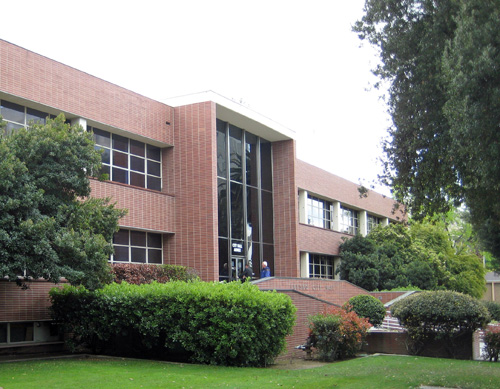Charles H. Franklin (1891-1956)
Charles H. Franklin was born in San Francisco on March 3, 1891. He apprenticed to Reid Bros in San Francisco in 1906. The Reids are generally recalled for their remarkable design of the world famous Hotel Del Coronado in Coronado (a suburb of San Diego).
 In 1912
Franklin moved to Fresno to work for the R. F.
Felchlin Company. Licensed as an architect in 1917, Franklin became a full
partner in the firm of Felchlin, Shaw & Franklin in 1925. The partnership
became one of the first full-service, turn-key firms in the State, and designed
or built many of Fresno's largest buildings, creating the skyline that
characterizes the city today. Among the firm's major projects were the
Bank of Italy Building (1918, on right), the
Patterson Building (1922), the
San Joaquin Light & Power Building (1923),
the Pacific Southwest Building (1923), and the
Radin & Kamp Department Store (1925).
Felchlin, Shaw & Franklin also built the Californian Hotel (1922), designed by
H. Rafael Lake for Sun Maid Hotel Corporation. It has
been said that "Felchlin got the jobs, Shaw made them look good, and Franklin
made them stand up."
In 1912
Franklin moved to Fresno to work for the R. F.
Felchlin Company. Licensed as an architect in 1917, Franklin became a full
partner in the firm of Felchlin, Shaw & Franklin in 1925. The partnership
became one of the first full-service, turn-key firms in the State, and designed
or built many of Fresno's largest buildings, creating the skyline that
characterizes the city today. Among the firm's major projects were the
Bank of Italy Building (1918, on right), the
Patterson Building (1922), the
San Joaquin Light & Power Building (1923),
the Pacific Southwest Building (1923), and the
Radin & Kamp Department Store (1925).
Felchlin, Shaw & Franklin also built the Californian Hotel (1922), designed by
H. Rafael Lake for Sun Maid Hotel Corporation. It has
been said that "Felchlin got the jobs, Shaw made them look good, and Franklin
made them stand up."
The firm of Felchin, Shaw & Franklin dissolved in
1930. For nearly five years, Franklin practiced alone as he undertook a series
of exploratory designs working in the new modernistic idioms.
 His Kearney Boulevard
Gateway of 1933, which strongly reflected constructivist design principles, was
an early demonstration of his natural ease expressing form through underlying
engineering. In 1935, Franklin received a commission for a modern home for
Fresno merchant Sam Pudlin. He assigned young Ernest J.
Kump, Jr., then a draftsman in Franklin's office and a passionate
modernist, the task of designing it. In 1936 Franklin and Kump designed a Dutch
Modern style "gem," the Fresno School Administration Building (on left), for
Allied Architects. They became partners in 1937. One
of their earliest advanced designs was Fowler Grammar School (1937).
His Kearney Boulevard
Gateway of 1933, which strongly reflected constructivist design principles, was
an early demonstration of his natural ease expressing form through underlying
engineering. In 1935, Franklin received a commission for a modern home for
Fresno merchant Sam Pudlin. He assigned young Ernest J.
Kump, Jr., then a draftsman in Franklin's office and a passionate
modernist, the task of designing it. In 1936 Franklin and Kump designed a Dutch
Modern style "gem," the Fresno School Administration Building (on left), for
Allied Architects. They became partners in 1937. One
of their earliest advanced designs was Fowler Grammar School (1937).
 Franklin &
Kump shot into national prominence when their radically modern Fresno City Hall
(1941, on right) was selected by the Museum of Modern Art as one of the most
significant American structures built between 1932 and 1944. During World War
II, Franklin left Fresno for the Bay Area, to work for the Corps of Engineers.
Franklin &
Kump shot into national prominence when their radically modern Fresno City Hall
(1941, on right) was selected by the Museum of Modern Art as one of the most
significant American structures built between 1932 and 1944. During World War
II, Franklin left Fresno for the Bay Area, to work for the Corps of Engineers.
After the war, Charles Franklin returned to Fresno. There he entered into a partnership with his former office manager, Alastair Simpson (1910-1992). Tragically, Franklin was forced into retirement in 1953, suffering at the height of his mature career from Lou Gehrig's disease. He returned to San Francisco and died there in 1956.
©1996 John Edward Powell. All rights reserved.